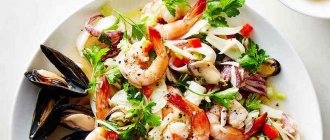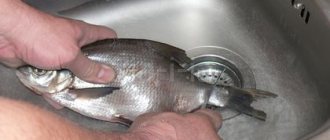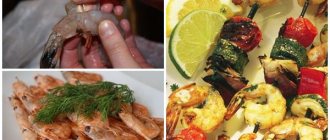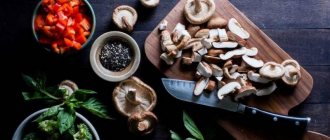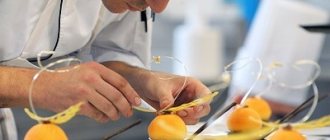A plate of amazing paella with shrimp, mussels, hot, freshly cooked lobster or a delicious salmon steak, hardly anyone would argue that eating seafood is very popular now. In many countries, seafood is not just a favorite food, but a basic element of the daily diet. For example, in Japan. The reason was unfavorable conditions for agriculture, and residents resorted to fishing to save themselves. You can learn other interesting facts about Japan.
Many countries boast delicious seafood dishes. For example, in the best restaurants in Dubai you will find a wide variety of seafood. In this article, we'll look at 10 surprising facts about seafood.
Lobsters and crabs can feel pain
Animal rights activists have long condemned the methods of preparing lobsters and crabs; boiling them alive is real torture, but lovers of lobsters and crabs justify themselves by saying that sea creatures do not feel pain, which is fundamentally false.
There is a theory that crustaceans have receptors in their bodies that respond to external stimuli, but do not cause pain . A group of scientists decided to refute this theory in practice. The crustaceans were subjected to rather cruel experiments, they were doused with acid, they were put into a state of shock, and each time irritation of certain areas was recorded. The research results provide evidence that crustaceans have a complex response to painful stimuli .
Popular types of seafood
The most common categories of various inhabitants of the deep sea that are suitable for food are the following: bivalves, which include oysters, mussels and scallops; cephalopods (octopuses, cuttlefish and squid); crustaceans (shrimp and crabs, lobsters or lobsters, krill, lobsters and crayfish); echinoderms - sea cucumbers, sea urchins, cucumbers and sea cucumbers; seaweed (kelp and fucus vesiculosa, spirulina, sea lettuce or ulva, porphyra and lithothamnia). Such an exotic, exciting world for every European as Japanese cooking uses seafood, the list of names of which contains the original names given in the Land of the Rising Sun.
Seaweed - nori, kombu, hijiki, wakame, kanten and umi budo - can be found in sushi and rolls prepared in Asian restaurants all over the planet.
Parasitic nematodes
Parasitic nematodes live in fish. Therefore, the products of global fishing companies are subject to scrupulous testing, but nevertheless, the chance to buy fish with nematodes exists.
To avoid such an unpleasant acquaintance, the fish must be properly prepared, paying special attention to heat treatment . If you eat uncooked or raw fish infected with nematodes, you are likely to experience vomiting, diarrhea and severe stomach cramps.
Shrimp vein
Shrimp has long been a favorite and world famous dish. But there is still no consensus on the shrimp vein, whether it needs to be removed before direct consumption. In fact, the shrimp's vein is the intestine, and most likely, food remains remain there.
Many seafood connoisseurs believe that the presence of veins affects the taste of the dish. Whether or not to remove it before consumption is a personal matter for every gourmet; it does not cause any harm to health.
Other beneficial properties of seafood
Having found out what constitutes seafood, the list of which includes a huge number of different living organisms edible for humans, and also having understood the whole world of animals, plants and algae, it is easy to determine how to replenish your diet with tasty and extremely beneficial delicacies. Shrimp meat is an ideal product for people who want to lose weight. High protein content, absence of sugars and fats - these qualities of crustacean representatives help a person to feast on them and at the same time lose weight. In addition, this type of seafood contains the highest concentration of vitamin B12, which activates hemoglobin synthesis, which perfectly strengthens the nervous system. Sea snails are leaders in the content of vitamin B6 and magnesium, elements that help prevent depression.
Mussels are record holders for the presence of vitamin E, a feminine remedy that maintains the beauty of skin, hair and nails. This powerful antioxidant regulates reproductive function and has anti-aging properties. In addition to natural protein, seafood is a major supplier of iodine and iron to our body, which improve brain function. People who regularly consume seafood are less likely to experience stress and resist depression. Nutritionists recommend including two to three meals a week containing seafood in your diet for proper nutrition. A list of dietary, low-calorie seafood allows a person to diversify the menu and at the same time feel full without gaining weight.
Wise salmon
A long-standing Irish legend tells of a wise salmon with a unique gift. According to legend, whoever eats salmon will gain the gift of foresight. One druid tried for a very long time to catch this magical fish in order to gain all its abilities. One day he succeeded and caught a salmon.
Naturally, the Druid did not want to eat raw fish and asked his assistant to cook salmon. And during the cooking process, the assistant got burned, and without hesitation, in order to cool his burnt finger, he stuck it into the fish’s mouth. At that same moment, all the charms and wisdom of the fish passed over him. Nothing could be corrected, so the student with the magical gift remained, and later became a great commander.
Shark fin cutting
To most foodies, the idea of cutting off shark fins for food seems ridiculous. In order to make a delicious fin soup, fishermen catch sharks, cut off their fins and release them back into the ocean to certain death .
More and more countries are banning such barbaric fishing methods. Today, the rules for shark fishing are becoming stricter . Despite all these atrocities, the soup continues to be consumed in China. The dish is expensive, and not every Chinese can afford it. Mostly shark fin soup is served at individual events and business receptions.
In fact, shark fins do not affect the taste of the dish, but only add a special texture.
Presentation "Seafood"
Slide 1
Seafood Author: 9a student of MBOU Secondary School No. 73 Anastasia Aleksandrovna Shchelokova Head: Olga Valentinovna Makarova
Slide 2
What is seafood? Seafood is everything that is caught in the seas and oceans, except fish and animals, and it can be eaten. squid shrimp crabs octopus lobsters lobsters algae mussels seaweed sea cucumbers oysters
Slide 3
Squids can reach up to 20 meters and weigh 800 grams. Squid meat is very healthy. It is rich in protein, which is very well absorbed by organisms. They are ideal for baby and diet food.
Slide 4
The size of different representatives of shrimp varies from 2 to 30 centimeters. Shrimp is a very protein-rich product. They also contain all the fat-soluble vitamins. These are vitamin K, A, E, D and the substances potassium, magnesium, phosphorus, iodine, copper, fluorine and others.
Slide 5
Crabs have five pairs of legs, with the first pair long ago turning into claws. The abdomen is quite long, and in most crabs moving sideways it is greatly reduced in size and tucked under the chest. Crab meat is a physiologically valuable food product. It contains 80.1-82.5% moisture, 0.2-1.4% lipids, 11.6-19.2% protein, 1.2-2.2% ash.
Slide 6
Octopuses are the most famous representatives of cephalopods; their bodies are short, soft, and oval at the back. On average up to 90 cm in length (including tentacles), the maximum length in males is up to 1.3 m, in females - up to 1.2 m. Weighs from 4.5 to 7 kg, maximum weight 10 kg. Octopus meat contains vitamins A, B1, B2, B3, B6, B9, B12, C, E, K, PP
Slide 7
Lobsters are decapod long-tailed crayfish. They are common in warm seas. Lobster meat is considered a delicacy; it is rich in various micro- and macroelements, especially phosphorus and calcium. In addition, the neck of the lobster contains potassium, sodium and magnesium.
Slide 8
Lobsters have a strong shell and ten legs, two of which have grown into claws. Lobster is considered one of the healthiest protein foods; it contains few calories, cholesterol and fat, but at the same time is rich in amino acids, potassium, magnesium, vitamins B12, B6, B3, B2, provitamin A.
Slide 9
Algae are the most common and numerous living creatures on Earth. They live in any environment in water and on land. They are used in medicine, cosmetology, as fertilizer and for water purification.
Slide 10
Their mussels are symmetrical and can close together very tightly. Mussel meat is pure, high-quality protein. It is rich in phosphatides. They contain various microelements, including zinc, manganese, iodine, cobalt, copper, about 20 essential amino acids, as well as vitamins B2, B6, B1, PP, as well as E and D.
Slide 11
Sea kale is an edible algae belonging to the class of brown seaweeds. Brown kelp algae contains a complex of biologically active substances: carbohydrates - 59%, proteins - 13%, fiber - 11%, fats - 2%, mineral salts - 3%, moisture - 12%. Sea kale contains iodine, bromine, manganese and other chemical elements, as well as vitamins: A, B1, B2, B12, C, D, E.
Slide 12
Sea cucumbers are invertebrate animals of the echinoderm type. The skeleton is greatly reduced. The body of the sea cucumber is elongated in cross-section, almost trapezoidal, somewhat flattened, especially in the lower part, worm-shaped; At one end there is a mouth, at the other there is an anus. Sea cucumber meat contains proteins, fats, vitamin B12, thiamine, riboflavin, mineral elements, etc.
Slide 13
Oysters An oyster is an edible bivalve marine mollusk, many species of which are edible. They live in tropical seas. Oyster meat contains protein, fat, glycogen carbohydrate, minerals: iron, zinc, copper, calcium, iodine, phosphorus, as well as vitamins B1, B2, B12 and PP.
Slide 14
A variety of seafood dishes Delicate creamy shrimp soup Seafood salad Seafood risotto Seafood spaghetti
Slide 15
Practical part
Slide 16
With seafood salad “Sea Cocktail” Equipment Grater Board Knife Bowls Ingredients Pack of sea cocktail 3-4 eggs 100g hard cheese Dill 2 small fresh cucumbers “Calve” sauce for fish Sour cream Green salad leaves Preparation technology Defrost a pack of sea cocktail. Add to seafood: finely grated eggs, grated cheese, chopped cucumbers, a little chopped dill. Season everything with sauce mixed with the same amount of sour cream. Place on green salad leaves.
Slide 17
Thank you for your attention!
Frozen fish
Usually, when eating sushi, we don’t think about what kind of fish it is made from - fresh or frozen. In many countries, there are a number of laws that require all fish to be frozen in order to eliminate certain types of bacteria .
Restaurants offering sushi to their guests only need a high-quality product, so fish can be frozen for a long period of time, up to several years. The most surprising thing is that even the most fastidious seafood connoisseurs cannot always distinguish the taste of frozen fish from freshly caught ones.
How to choose the right seafood: pros and cons
A significant advantage of many seafood is associated with their quick preparation, which is important for cooks and ordinary housewives. Of the minuses, we can name only one - seafood rarely comes to us fresh, as it quickly spoils. But after shock freezing, their nutritional value does not deteriorate at all, so an even thin layer of ice glaze on seafood indicates their good quality. They can only be sold alive in coastal areas or near farms where they are grown under artificial conditions.
Seafood can be raw or boiled and then frozen, the list of which includes squid, sea cucumbers, scallop fillet, kelp and other seafood. You can find shrimp or sea cucumbers in dried form in stores. From canned products obtained from the sea, the food industry produces crabs, squid, shrimp, scallop fillets, seaweed and other species. Salted and smoked seafood is often served as an appetizer with beer.
Mahi-mahi is not a dolphin
For a long time, mahi-mahi fish were classified as members of the dolphin family, which is incorrect . After all, she doesn’t even have the slightest resemblance to dolphins, but there are reasons for everything.
Mahi-mahi usually swims near fishing boats, which is similar to the behavior of dolphins. Due to its resemblance to a dolphin, mahi-mahi fish were not caught for sale for a very long time. Buyers mistook this fish for a dolphin, and as you know, dolphin meat contains a large amount of mercury, which is dangerous for humans.
Fish spread from Scandinavia
Residents of the states do not find it strange to eat peanut butter. In other parts of the world, eating peanut butter seems unpleasant. For example, Scandinavians have found an alternative to oil - fish spread . Not only is pate made from fish, but it is also salted and pickled. Herring is one of the most popular dishes among northerners , in addition, it is very good for health.
Advantages of products obtained from the sea
The average caloric content of most seafood is 80-85 kcal per 100 g of healthy food. The type and chemical composition of the inhabitants of the deep sea are directly related to their energy value. For example, shrimp meat is rich in minerals beneficial to human health: calcium and magnesium, sulfur, phosphorus and iron.
Carcasses of squid or octopus are mega-sources of vitamins B and C. At the same time, 100 g of mussel meat contains only 3 g of fat, and carcasses of squid and shrimp contain even less of this nutrient, which has a positive effect on the calorie content of the diet for those losing weight, which is based on Fish and seafood. The list of their beneficial properties also includes the presence of polyunsaturated fatty acids omega-3 and omega-6. These substances improve the functioning of the cardiovascular system, reduce cholesterol levels, and stabilize hormonal levels. In addition, seafood products normalize digestion, stimulate metabolic processes in the body, and reduce the risk of the occurrence and development of cancer.
What months do you eat oysters?
There is a belief that oysters can only be eaten in those months of the year that have the letter "P", for example, September . There is a lot of evidence for this fact, but, frankly speaking, all of it is not scientific.
This legend most likely has its origins in Native American culture . The idea is that the months that don't have the letters "R" are summer months. In summer, algae actively bloom, from which many toxins dangerous to humans can enter oysters .
Nowadays, we have nothing to fear, since all the oysters that end up on the shelves of our stores are grown on special farms, and any influence of toxins from algae is excluded.
Acne and the discovery of anaphylaxis
Of all seafood dishes, there is one product that must be subjected to heat treatment under any conditions - eel. Eating raw eel, unfortunately, can be fatal. Freezing an eel will, of course, rid it of bacteria, but not of toxins. The only way to enjoy such a delicacy without compromising your health is to cook it correctly!
Thanks to such a poisonous product, anaphylaxis, a hypersensitivity reaction, was discovered. At the beginning of the 20th century, a number of experiments were carried out in which they tried to build immunity to eel blood in dogs. Unfortunately, the experiments did not yield positive results. The dogs did not develop immunity to poisonous blood; in all cases, an anaphylactic reaction was observed, often with a fatal outcome.
What seafood is used for cooking? Edible inhabitants of the northern seas
Thanks to the harsh climatic conditions, representatives of the water element of the North develop very slowly and reach enormous sizes. The fauna of the Arctic Ocean is a supplier of the largest mussels, reaching from 10 to 20 centimeters in length, shrimp up to 30 cm in size, giant squid, the growth of which can reach 5 meters! The longevity of living organisms in cold Arctic waters distinguishes northern seafood from their southern counterparts. For example, mussels of the Barents Sea can survive for about 25 years (in the Black Sea, these mollusks live only about 6 years). In addition, fish such as haddock, cod, cod and capelin, as well as shrimp, are caught in the Barents Sea.
In the total catch, the share of catfish and ruffed flounder is quite large. They catch herring of the same name, Pechora and White Sea navaga. In the sixties of the last century, breeding began in the Barents Sea, and since 2002, commercial fishing has been organized. Processed fish, crabs and shrimp are frozen at sea, on ships, the exclusive distributor of which is the Northern Seafood company. After purchasing seafood delicacies - shrimp or crabs - you need to defrost them a little in cold water or on the bottom shelf of the refrigerator and boil them. Cooked crab meat is used as an appetizer or a separate dish, shrimp is boiled or fried, served with sauces, stuffed with vegetables or eggs, added to various salads, prepared sandwiches with them, and added to soups.
